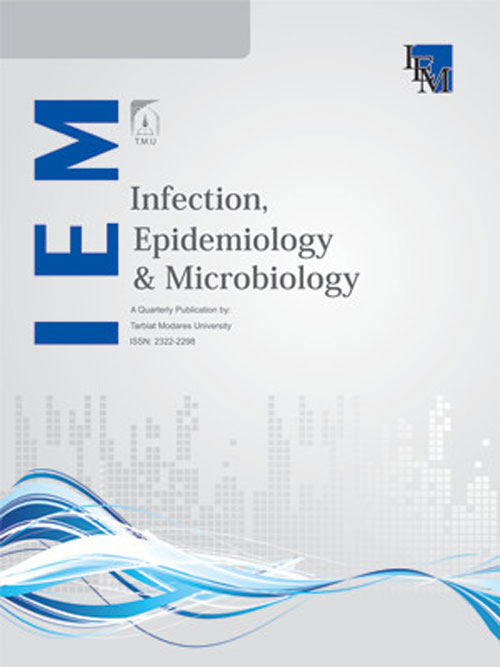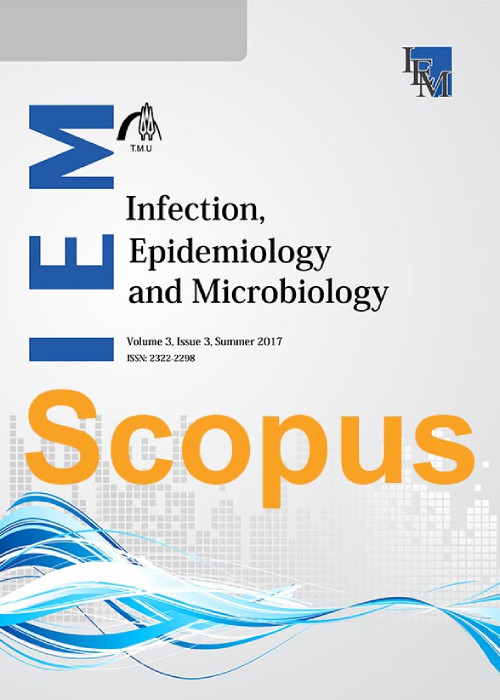فهرست مطالب

Infection, Epidemiology And Medicine
Volume:4 Issue: 1, Winter 2018
- تاریخ انتشار: 1396/12/20
- تعداد عناوین: 6
-
-
Pages 1-4Aims: Many infectious diseases had traditionally been cured with herbal medicines. Antimicrobial agents are often produced synthetically to increase the food durability and quality. The purpose of this study was to determine the antimicrobial properties of the aqueous and alcoholic extracts of Allium schoenoprasum.Materials and MethodsIn this experimental study, after preparation Allium schoenoprasum samples, aqueous and alcoholic extracts were prepared and their minimum inhibitory concentration (MIC) was determined against Staphylococcus aureus, Bacillus cereus, Escherichia coli and Vibrio cholerae by micro broth dilution method. Erythromycin was used as the control.
Findings: The MIC of alcoholic and aqueous extracts of A. schoenoprasum was 16-256 and 32->256µg/ml, respectively and MBC of them were 32-256 and 64->256ug/ml, respectively. The A. schoenoprasum exhibited higher activity against S. aureus and B. cereus strains.ConclusionThe extracts of A. schoenoprasum have antimicrobial effect on S. aureus, B. cereus, E. coli and V. cholerae strains in micro broth dilution method.Keywords: Antimicrobial Agents, Allium schoenoprasum, Escherichia coli, Vibrio cholerae, Staphylococcus aureus -
Pages 5-12Aims: There are few data regarding the prevalence and trends of Klebsiella pneumoniae antibiotic resistance in Algeria. The present study was conducted to investigate the spatial distribution of K. pneumoniae antibiotic resistance phenotypes in time and according to specimen source.Materials and MethodsThis retrospective study was performed between January 2011 and December 2015 at Mila Hospital, Algeria. A total of 172 K. pneumoniae were isolated from consulting and hospitalized patients, and their antimicrobial susceptibility was tested. The Principal Component Analysis (PCA) was used to study correlations among antimicrobial resistance phenotypes observed, and Factorial Correspondence Analysis (FCA) was used to study the spatial distribution of antibiotic resistance phenotypes according to specimen source.
Findings: The specimens were obtained from urine (n=89), vagina (n=39), pus (n=33), blood (n=9) and surgery (n=2). PCA showed two principals associations of resistance phenotypes gathered in two clusters. The first profile regroups amoxicillin-clavulanic acid, cefazolin and ampicillin. The second assembles cefotaxime, nalidixic acid and sulfamethoxazole-trimethoprim. In FCA, nalidixic acid was connected with urine specimens, registering maximum resistance (52.8%) compared to the other samples. Vagina specimens were associated to sulfamethoxazole-trimethoprim and colistin phenotypes registering maximum resistances with 89.7 and 76.9%, respectively. Pus manifested a near association to cefotaxime with a maximum resistance (48.5%).ConclusionThe model developed in FCA, highlights typical associations of antibiotic resistance phenotypes to specimen source and confirms the difference in resistance profile according the source of specimen in K. pneumoniae infections.Keywords: Klebsiella pneumoniae, Antibiotic Resistance, Clinical Specimens, Multivariate Analysis Algeria -
Pages 13-17Aims: Klebsiella pneumoniae is a Gram-negative opportunistic pathogen. The carbapenems are effective therapeutic choice for the treatment of Klebsiella pneumonia infections. Carbapenemases are a group of enzymes capable of hydrolyzing carbapenems. This study was to introduce phenotypic and genotypic methods to identify the carbapenemase-producing isolates of Klebsiella pneumoniae.Materials and Methodsthis study was to introduce phenotypic and genotypic methods to identify the carbapenemase-producing isolates of Klebsiella pneumoniae. The Modified Hodge Test (MHT) was performed to determine the susceptibility of isolates to antibiotics. The final products of PCR were electrophoresed on agarose gel.
Findings: The highest rate of resistance were observed for piperacillin (84%) and the lowest for ertapenem (50%). The majority of MHT positive isolates was from urine (64.7%), while abdominal and cerebrospinal fluids (0%) were the lowest. In addition, the ICU wards with 47 (69.1%) and the emergency units with 4 (5.9%) samples, had the most and the least frequent cases, respectively. MHT was positive in 68 K. pneumoniae isolates, but none of them were positive for blaKPC gene.ConclusionThe blaKPC gene has low prevalence in the Isfahan City, Iran.Keywords: Klebsiella pneumonia, Carbapenemase, PCR, Prevalence -
Pages 19-25BackgroundChlamydia trachomatis infection is a sexually transmitted disease that its majority infections are asymptomatic and can cause infertility. So, determining its frequency and prevalent genotypes in each zone is necessary to provide clues for clinicians and also to prevent or minimize its complications. The aim of this study was determining the prevalence of C. trachomatis and related genotypes in infertile women and relation with type of infertility.MethodsFor this purpose, a primary screening based on amplification of cryptic plasmid gene was done on endocervical samples obtained from infertile women referring to two infertility treatment clinics. Genotyping of positive samples was done based on PCR-RFLP of omp1 gene and then DNA digestion with Hpa II, Hinf I and Alu I restriction enzymes. The association of infection with age, abortion and primary and secondary infertility was analyzed by statistical analysis.ResultsAs a result of this study, the frequency of C. trachomatis infection in 180 endocervical samples was 10.5 % in infertile women. The PCR-RFLP analysis results showed that E, F and D genotypes are prevalent in this population. There was a significant association between infection and abortion among patients with primary and secondary infertility.ConclusionsFinally, based on the obtained results it can be concluded that C. trachomatis infection is prevalent in infertile women especially in secondary infertility. So, it must be regarded in preventive care and control program hence its diagnosis and treatment can reduce infertility rate among women.Keywords: Chlamydia trachomatis, Genotype, Infertility, Omp1 gene
-
Pages 27-32IntroductionThe use of antibiotics in food-producing animals has elevated concerns regarding their potential affect on human health. Resistant Salmonella may be transmitted through the food chain to humans. The aim of this study was to determine the prevalence of tetracycline resistance genes among tetracycline-resistant Salmonella enterica from Iran.
Material andMethodsIn this experimental study, A total of 4369 stool specimens were collected via rectal swab from hospitalized children under the age of 5 with watery diarrhea, with or without blood, mucus and stomach cramps. Antimicrobial susceptibility profiles of Salmonella isolates were performed and Minimum inhibitory concentration (MIC) of tetracycline was assessed. Bacteria were grown on blood agar at 37°C overnight, and genomic DNA was extracted. For evaluating of PCR products used of 1.5% agarose gel in TBE buffer at for 80min.
Findings: High level of resistance was observed against minocycline (78.5%), tetracycline (76.0%), nalidixic acid (66.6%) and streptomycin (42.0%). The MIC for 46.0% of the isolates was 256µg/ml, while 15.6% showed the MIC of 128µg/ml and the remaining revealed 64µg/ml MIC to tetracycline. Among the 33 tetracycline-resistant isolates the tet(A) or tet(B) genes were detected in 10 (23.8%) and 5 isolates (11.9%), respectively. The tet(A)and tet(B) genes were identified in 2 out of the 42 tetracycline-resistant Salmonella isolates (4.8%). The tet(C) or tet(D)genes were not found among tetracycline-resistant isolates.ConclusionResistance to Salmonella strains is increasing. The predominant tetracycline-resistant gene is tet(A) followed by tet(B).Keywords: Salmonella enterica| antimicrobial resistance| tetracycline -
Pages 35-40Aims: Infections by extended-spectrum beta-lactamase (ESBL) and carbapenemase-producing Enterobacteriaceae (CPE) are increasing problems in pediatrics and are usually associated with higher hospital costs and mortality rates. The aims of this study were the statistical investigation of the worldwide prevalence and risk factors of ESBL and CPE family members among pediatric population.
Instruments andMethodsFrom October 1, 1995 to July 27, 2017, some keywords including ESBLs, carbapenemase, pediatrics, children, and risk factor were searched in the searching databases such as Google Scholar, Embase, Scopus, PubMed, and Web of Science among original research articles. The univariate and multivariate analysis of the collected data was performed by Graph Pad Prism 6.1 software.
Findings: The mean percentage of ESBL production was 20.23±22.31 and the mean percentage of CPE was 1.81±2.77. E. coli (n=991) and K. pneumonia (n=627) were the predominant ESBL-producers. Nephrology (n=5005) and NICU (n=1805) were predominant hospital wards. ESBL-PE had significantly higher prevalence in the infants unit (OR=0.9832, 95% CI=12.271-19.519; pConclusionMost of risk factors between ESBL-PE and CPE are similar including previous hospitalization and prolonged use of antibiotics, cephalosporins, and previous colonization. Other possible potential risk factors that should be considered include presence of catheters and travel history. Detection of risk factors provides useful information for formulation of infection control policy.Keywords: Enterobacteriace, Extended-spectrum beta-lactamase, Carbapenemases, Risk Factors


